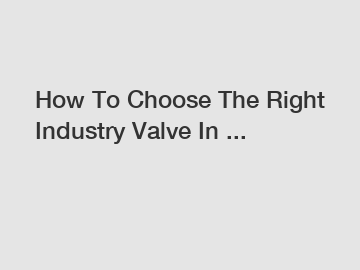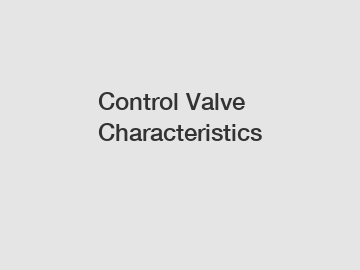Advantages and disadvantages of gate valve and its scope ...
Advantages and disadvantages of gate valve and its scope ...
This article will explain the advantages and disadvantages of gate valves and the scope of application. A gate valve is a valve in which the opening and closing part moves along the vertical direction of the pipeline channel axis. The
If you are looking for more details, kindly visit our website.
opening and closing part is called a gate, which is mainly used to cut off the flowing medium in the pipeline and can only be used fully open or fully closed. Therefore, the gate valve cannot be used as a regulating valve to regulate flow. Gate valves of different materials are adapted to different environments and temperatures, but gate valves are generally not used in pipelines that transport mud and other media, because these media contain impurities, which will affect the sealing effect of the gate.
Advantages of gate valve:
1. It can only be fully open and fully closed. When the gate is fully open, the resistance of the fluid through the valve is small;
2. The torque required for opening and closing is small and labor-saving;
3. It can be used in pipelines where the medium flows in both directions, and the flow direction of the medium is not restricted;
4. Compared with the shut-off valve, when the gate valve is fully opened, the degree of erosion and erosion of the sealing surface by the fluid medium is low;
5. Simple structure, convenient installation and use, and good manufacturing technology;
6. The overall structure length of the valve is relatively short.
Disadvantages of gate valve:
1. The overall dimensions and opening height are relatively large, which requires a large installation space;
2. When the gate is opened and closed, the friction with the sealing surface of the valve seat is large, causing certain wear on the sealing surface;
3. Usually the gate valve has two sealing surfaces, which is difficult to process and grind, and it is quite troublesome to maintain;
4. It takes a long time to open and close.
Gate valves usually have more applications in the following areas:
1. Oil and natural gas pipelines.
2. Transportation pipeline and storage equipment of refined oil.
3. Wellhead equipment for oil and natural gas exploitation.
4. City gas transmission pipeline.
5. Tap water and sewage treatment projects.
TH Valve is a professional manufacturer of butterfly valve, gate valve, check valve, globe valve, knife gate valve, ball valve with API, JIS, DIN standard, used in Oil, Gas, Marine industry, Water supply and drainage, fire fighting, shipbuilding, water treatment and other systems, with Nominal Diameter of DN50 to DN1200, NBR/EPDM/VITON, Certificates & Approvals: DNV-GL, Lloyds, DNV, BV, API, ABS, CCS. Standards: EN 593, API609, API6D
Exploring the Distinctions in Usage: Ball Valve vs. Check Valve
Everything You Need To Know To Find The Best DIN Y Type Strainer
Comprehensive Guide: Maintaining Pneumatic Valves for Optimal Performance
A Brief Rundown of a Trunnion Ball Valve
Differences Between DIN Cast Steel Gate Valve Designs
Key Questions to Ask When Ordering Socket Resilient Seat Gate Valve
Goto kairuite to know more.
Related links:Five China Ball Valve Manufacturing Companies to Watch Out ...
Related news/knowledge:
Advantages of Using an Industrial Gate Valve
By Carson Hu
•
24 Oct, 2019
Right now, there are over 3,000 facilities on the Outer Continental Shelf involved in the collection and treatment of oil and gas. These oils and gases are collected from wells -- a process that's performed using certain types of high pressure valves. Of course, different types of American ball valves offer different results and it's crucial that the right projects are executed with the right types of valves. Quite often, the types of valves being used are ball valves, sometimes referred to as pig ball valves or pig vales (as they are used in conjunction with pipeline pigging systems). Before sourcing and investing in valves, it is important to understand the degree to which these valves may differ from one another. Let's delve into some of the defining characteristics of ball valve types. Ball Valve Body Styles Before getting into the exact types of ball valves that are available at the moment, it's important to remember that there are actually four separate types of body styles. These include the single body, split body, top entry, and welded styles. The styles of ball valves available differ from the types of ball valves available. This means that there are number of potential variations that you can see in ball valves. The great thing about this variety is that it means that there is more potential applicability in ball valves than there would be otherwise. Full Port Ball Valves: Turning to the different body types of ball valves, we can first look at the full port ball valve. A full port ball valve is defined by the fact that it has an oversized ball. The oversized ball has a purpose -- it is the same size as the pipeline. This means that there will be less potential friction less than there would be if the ball wasn't the same size as the pipeline, and the flow involved is unrestricted. The valve is larger as well. Standard Port Valves: As their name suggests, standard port valve are quite usual. This means they're less expensive than some alternatives. This type of valve has a smaller ball, and therefore the valve itself is smaller as well. The flow going through the pipe will in turn be smaller and will typically be about one pipe size smaller than the valve's pipe size. This makes it more restricted. The V Port Ball Valve: The V port ball valve is named after its V-shaped seat. What this means is that the orifice through which the product flows can be more easily opened and closed to change its direction. While many like this idea, the construction of this type of valve means that it can't be used just anywhere. It typically needs to be utilized in a more secure site. When the valve is opened, it is usually opened at the "small end" first, which helps stabilize the flow control. Trunnion Ball Valve: Then there is the trunnion ball valve, which doesn't exactly give much away through its name. This type of valve will actually anchor the valve at the top and the bottom through a particular mechanism. This would be applied on larger and more high pressure valves. While this type of valve isn't going to fit everyone's needs, it can definitely be used for particularly high pressure projects. Manually Operated Valves: Finally, these types of valves can be closed more quickly than their counterparts. Though this is an advantage in some cases, it also means that there can be a risk of a water hammer. These can include an actuator, which can be pneumatically or motor operated, which will in turn be used for on/off flow control. The valve will also have a positioner, which transforms the control signal into an actuator position. The flexibility of this type of valve is certainly an advantage to most projects. Now that you're more familiar with the styles and types of ball valves, you'll be in a better position to make decisions that will support your needs. For more information, please contact us today.
For more information, please visit gate valves manufacturer.
The main differences between cryogenic ball valves and cryogenic globe valves
4 Tips to Selecting a Sleeve Type 3-Way Plug Valve
Pinch Valve - How They Work
Proper Valve Identification and Labeling Standards and Tips
Advantages of Cast Iron Valves
What are Cryogenic Valves?
What Are Throttling Valves? | XINTAI-Industrial Valve Factory





